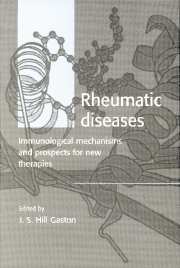Book contents
- Frontmatter
- Contents
- List of contributors
- 1 Implications of advances in immunology for understanding the pathogenesis and treatment of rheumatic disease
- 2 The role of T cells in autoimmune disease
- 3 The role of MHC antigens in autoimmunity
- 4 B cells: formation and structure of autoantibodies
- 5 The role of CD40 in immune responses
- 6 Manipulation of the T cell immune system via CD28 and CTLA-4
- 7 Lymphocyte antigen receptor signal transduction
- 8 The role of adhesion mechanisms in inflammation
- 9 The regulation of apoptosis in the rheumatic disorders
- 10 The role of monokines in arthritis
- 11 T lymphocyte subsets in relation to autoimmune disease
- 12 Complement receptors
- Index
1 - Implications of advances in immunology for understanding the pathogenesis and treatment of rheumatic disease
Published online by Cambridge University Press: 06 September 2009
- Frontmatter
- Contents
- List of contributors
- 1 Implications of advances in immunology for understanding the pathogenesis and treatment of rheumatic disease
- 2 The role of T cells in autoimmune disease
- 3 The role of MHC antigens in autoimmunity
- 4 B cells: formation and structure of autoantibodies
- 5 The role of CD40 in immune responses
- 6 Manipulation of the T cell immune system via CD28 and CTLA-4
- 7 Lymphocyte antigen receptor signal transduction
- 8 The role of adhesion mechanisms in inflammation
- 9 The regulation of apoptosis in the rheumatic disorders
- 10 The role of monokines in arthritis
- 11 T lymphocyte subsets in relation to autoimmune disease
- 12 Complement receptors
- Index
Summary
Advances in immunology
This book has been designed to meet the needs of those whose clinical or research interests are in rheumatic diseases. Within rheumatology, there has been a lively debate on the relevance or otherwise of advances in immunology to a better understanding of rheumatic diseases and their treatment. Until relatively recently, it would have to be conceded that treatment of a disease like rheumatoid arthritis (RA) has been based on empirical observation of the usefulness of certain drugs (usually tested originally on the basis of some wholly erroneous idea about pathogenesis); in short, rational therapies based on a new understanding of immunopathology were in short supply. This situation is now changing, with the successful application of ‘biologic’ treatments, such as antibodies to tumour necrosis factor alpha (TNFα), or recombinant interleukin 1 (IL-1) receptor antagonist in RA (Arend & Dayer, 1995; Maini et al., 1995), and the initial exploration of supplying such therapy by means of gene transfer (Evans & Robbins, 1996). It is very likely that much of the therapeutic effort of rheumatologists in the first part of the 21st century will be directed to defining the place of novel biological therapies in the management of rheumatological disease, while determining in more detail the mode of action of current empirical therapies so that they may be used to best advantage.
In order to participate in this process, it is necessary to have at least some working knowledge of the components of the immune system, and how they might be implicated in rheumatic disease.
- Type
- Chapter
- Information
- Rheumatic DiseasesImmunological Mechanisms and Prospects for New Therapies, pp. 1 - 12Publisher: Cambridge University PressPrint publication year: 1999



